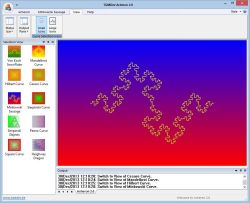The major contribution of Benoit Mandelbrot was to open the fascinating field of the fractal geometry using facts known long before he wrote his first book about fractals: Peano Curve, Von Koch Curve, Sierpinsky Objects, Hausdorff-Besicovitch dimension, ... However, as many others, his name is also attached to an interesting fractal curve based on a simple iterator.
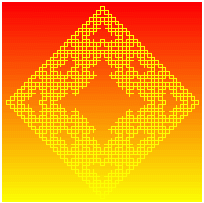
Construction Back to Top
As almost all fractals curves, the construction of the Mandelbrot curve is based on a recursive procedure.
The fisrt iteration is obtained by dividing a straight line into three equal segments and then applying the Mandelbrot iterator.
The first iteration gives the following picture:
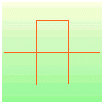
The procedure is then repeated with the eight segments generated by the previous iteration.
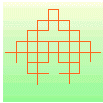
In the third iteration, it's already hard to find out the way through.
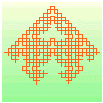
Properties Back to Top
- Curve Length
- Fractal Dimension
- Self-Similarity
The length of the Mandelbrot curve increases at each iteration. On each iteration, the length of the segments is divided by three and the number of segments is multiplied by eight, hence the total curve length is multiplied by 2.66666 with each iteration.
Obviously, the length of the curve tends to infinity as the iteration number increases.
The fractal dimension is computed using the Hausdorff-Besicovitch equation:
D = log (N) / log ( r)
Replacing r by three ( as each segment is divided by three on each iteration) and N by four ( as the drawing process yields 8 segments) in the Hausdorff-Besicovitch equation gives:
D = log(8) / log(3) = 1.8928
Looking at two successive iterations of the drawing process provides graphical evidence that this property is also shared by this curve.
All Variations described are available using Acheron 2.0
- Iteration Level
- Basic Geometric Figure
- Style
Eight recursion levels are available. The drawings change dramatically with the first iterations and then remains quite constant, whatever the iteration number.
Instead of starting with a straight line, the drawing can start from a square.


The original iterator can be clipped, leading to a very different drawing.

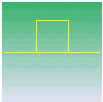
Note that the clipped grain leads to a fractal curve with a lower fractal dimension ( D = 1.6309)
 Born: 20 Nov 1924 in Warsaw, Poland
Born: 20 Nov 1924 in Warsaw, Poland Died: 14 Oct 2010 in Cambridge, Massachusetts, US
Benoit Mandelbrot was largely responsible for the present interest in fractal geometry. He showed how fractals can occur in many different places in both mathematics and elsewhere in nature.
Mandelbrot was born in Poland in 1924 into a family with a very academic tradition. Mandelbrot was introduced to mathematics by his two uncles.
Mandelbrot's family emigrated to France in 1936 and his uncle Szolem Mandelbrojt, who was Professor of Mathematics at the Collège de France, took responsibility for his education. Mandelbrot attended the Lycée Rolin in Paris up to the start of World War II. He completed his studies at the Ecole Polytechnique of Paris. The, Mandelbrot went to the Institute for Advanced Study in Princeton where he was sponsored by John von Neumann.
Mandelbrot returned to France in 1955 and worked at the Centre National de la Recherche Scientific. He married Ailette Kagan and shortly after returned to the United States.
In the 1970s, with the aid of computer graphics, Mandelbrot who then worked at IBM's Watson Research Center, was able to show how Julia's work is a source of some of the most beautiful fractals known today. To do this he had to develop not only new mathematical ideas, but also he had to develop some of the first computer programs to print graphics.
His work was first put elaborated in his book Les objets fractals, forms, hasard et dimension (1975) and more fully in The fractal geometry of nature in 1982.
Mandelbrot has received numerous honours and prizes in recognition of his remarkable achievements. In 1985 Mandelbrot was awarded the 'Barnard Medal for Meritorious Service to Science'. The following year he received the Franklin Medal. In 1987 he was honoured with the Alexander von Humboldt Prize, receiving the Steinmetz Medal in 1988 and many more awards including the Nevada Medal in 1991 and the Wolf prize for physics in 1993. In 1999, Mandelbrot received the Honorary Degree of Doctor of Science from the University of St Andrews.
Biography From School of Mathematics and Statistics - University of StAndrews, Scotland
